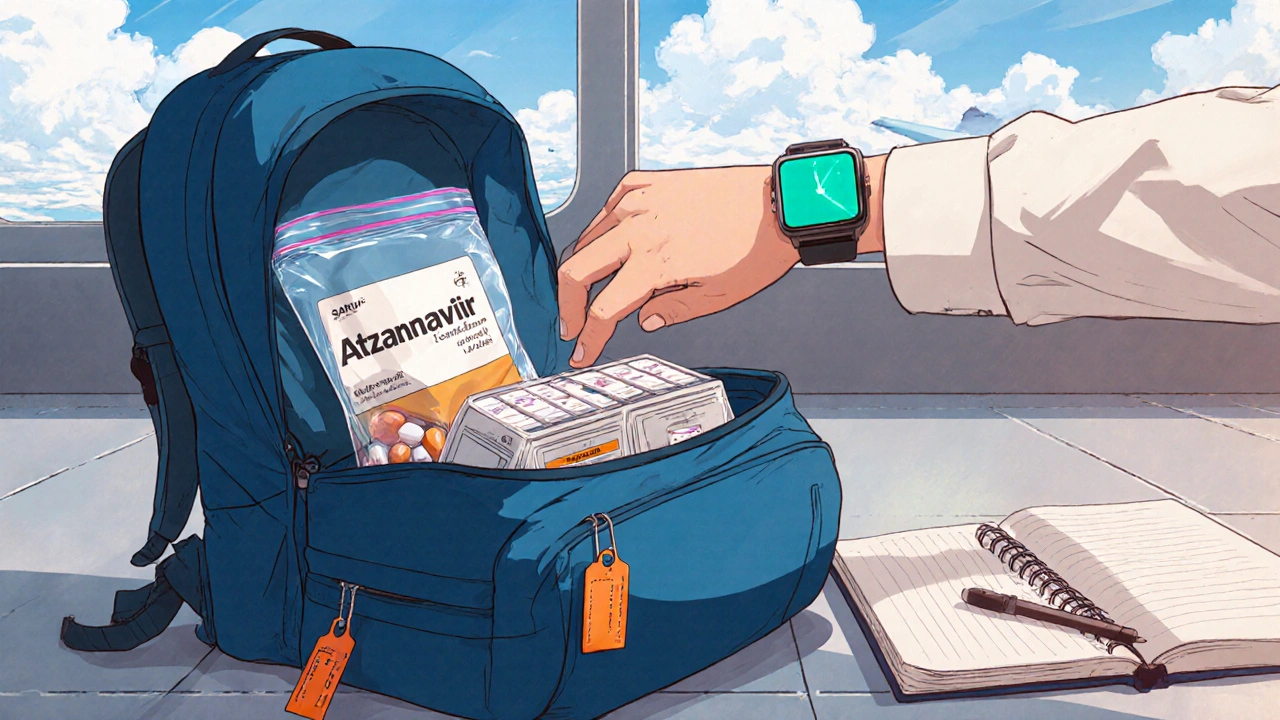Atazanavir Adherence Tracker
Daily Adherence Log
Adherence Status
Adherence Guidance
Adherence is critical: Consistent use keeps the virus suppressed. A 95% adherence rate is the target for effective HIV therapy.
Today's Result
Keep up the good work! Consistent adherence helps prevent drug resistance and maintains your health.
Missed Dose Calculator
Adherence Impact
We recommend discussing this with your healthcare provider.
Sticking to an Atazanavir schedule can feel like a daily puzzle, especially when life throws curveballs. The good news is that a few practical tweaks can turn that puzzle into a smooth routine, keeping the virus in check and your health on the rise.
What is Atazanavir?
Atazanavir is a protease inhibitor used in combination antiretroviral therapy (ART) to suppress HIV replication. First approved in 2003, it’s taken once daily with a low‑fat meal or on an empty stomach, depending on the formulation. The drug works by blocking the HIV protease enzyme, preventing the virus from maturing and spreading.
Why adherence matters for HIV therapy
Missing doses isn’t just a missed pill; it can let the virus bounce back, raise the viral load, and drop the CD4 count. Studies from the International AIDS Society show that an adherence rate above 95% keeps the virus suppressed in over 90% of patients. When you stay on track, you reduce the risk of resistance, avoid hospital visits, and keep your energy for what matters.
Common challenges with an Atazanavir regimen
- Food requirements: The capsule form needs a low‑fat meal, while the soft‑gel can be taken without food. Forgetting the right intake can cause stomach upset.
- Side effects: Jaundice, nausea, and mild abdominal cramps are reported in up to 20% of users.
- Pill burden: Even a single daily pill can feel heavy when combined with other meds.
- Drug interactions: Antacids, some antibiotics, and herbal supplements can lower Atazanavir levels.
- Travel and routine changes: Shifts in time zones or work schedules disrupt reminders.
Practical tips to stay on track
Below are proven strategies that fit into most daily lives.
- Set a non‑negotiable alarm: Use your phone’s “medication” label, or a dedicated reminder app that flashes the screen and sounds an audible cue.
- Pair with a habit: Take Atazanavir right after you brush your teeth or pour your morning coffee. The habit loop (cue‑routine‑reward) makes forgetting harder.
- Use a pill organizer that fits your schedule: Weekly boxes work well for a once‑daily dose; keep the compartment for Atazanavir separate from other meds to avoid mix‑ups.
- Plan for travel: Pack a small zip‑lock bag with enough pills for the whole trip plus an extra day. Adjust alarms to the new time zone before you land.
- Keep a medication diary: A simple notebook or an app note can flag missed doses instantly, letting you discuss patterns with your clinician.
- Ask your pharmacy about refill synchronization: Align all your prescriptions to refill on the same day, reducing trips to the counter.

Managing side effects
Side effects are the top reason people skip doses. Here’s how to keep them in check:
- Jaundice (yellowing of skin): Usually mild. Stay hydrated, avoid alcohol, and inform your doctor if the color deepens.
- Nausea: Take the capsule with a light snack-think toast or a banana. If nausea persists after a week, your clinician may adjust the dose or add an anti‑nausea medication.
- Abdominal cramps: Split the pill into two halves (if your pharmacist agrees) and take each with a half‑fat meal.
Using tools and support systems
Technology and community can be game‑changers.
- Medication reminder apps: Apps like Medisafe or MyTherapy let you log each dose, set refill alerts, and share adherence reports with your doctor.
- Adherence counseling: Many HIV clinics offer one‑on‑one sessions that explore barriers and co‑create solutions.
- Support groups: Online forums and local meet‑ups provide peer encouragement-knowing someone else who faces the same hurdles can boost motivation.
Daily adherence checklist
| Barrier | Strategy |
|---|---|
| Forgotten dose | Set phone alarm with label "Atazanavir"; pair with morning coffee |
| Food confusion | Keep a low‑fat snack on the table; use a sticky note on the pill bottle |
| Side‑effect anxiety | Log symptoms in a diary; discuss trends with clinician within 2 weeks |
| Travel disruption | Pack extra pills; adjust alarm to destination time zone ahead of travel |
| Drug‑interaction risk | Maintain an updated list of all meds/supplements; review with pharmacist quarterly |
Print this table or save it on your phone. When you tick off each strategy, you reinforce the habit loop and keep the virus suppressed.

When to seek professional help
If you notice any of the following, reach out promptly:
- Persistent yellowing of skin or eyes.
- Severe nausea or vomiting that keeps you from taking the dose.
- Frequent missed doses (more than 2 in a week).
- New medications that might interact with Atazanavir.
Your healthcare team can adjust the regimen, add supportive meds, or explore alternative protease inhibitors.
Quick recap of key actions
- Set a labeled alarm and pair it with a daily habit.
- Use a pill organizer and keep extra pills handy.
- Document side effects and discuss them early.
- Leverage apps, counseling, and support groups.
- Review medication list with your pharmacist every three months.
Frequently Asked Questions
How long does it take for Atazanavir to lower my viral load?
Most patients see a significant drop in viral load within 4 to 8 weeks when the drug is taken consistently. Regular blood tests every 3 months help track progress.
Can I take Atazanavir with a high‑fat meal?
High‑fat meals can increase Atazanavir absorption dramatically, leading to higher blood levels and more side effects. Stick to a low‑fat snack or take the soft‑gel version without food.
What should I do if I miss a dose?
If it’s less than 12 hours late, take it as soon as you remember. If more than 12 hours have passed, skip the missed dose and resume your regular schedule. Don’t double‑dose.
Are there any over‑the‑counter meds I should avoid?
Antacids containing aluminum or magnesium can lower Atazanavir levels. Check labels and talk to your pharmacist before using any new OTC product.
Is it safe to drink alcohol while on Atazanavir?
Moderate alcohol isn’t a direct interaction, but excessive drinking can worsen liver function and increase jaundice risk. Keep alcohol intake low and monitor your liver enzymes.
How can I involve my family in my adherence plan?
Share your daily reminder system with a trusted family member. Ask them to check in once a week or keep the medication in a visible spot at home.

alex montana
October 17, 2025 AT 21:12Wow!!! I just read that Atazanavir schedule thing and I feel like it's a never‑ending maze-what? you gotta remember a low‑fat snack, set alarms, pack extra pills-Ugh!!! It’s like every day they add another rule and my brain just melts...
kendra mukhia
October 19, 2025 AT 21:53Let me tell you the cold hard truth about these adherence guides, they read like a self‑help novel for the chronically confused.
You scroll through bullet points, and the only thing you actually remember is that your phone alarm is louder than your desperation.
First, the notion that a single pill can be a life‑saver is romanticized to the point of absurdity.
Second, the low‑fat snack requirement is a culinary nightmare for anyone who enjoys a decent breakfast.
Third, the side‑effects list reads like a horror movie script, and yet the article glosses over the emotional toll.
Fourth, the travel advice assumes you have a spare suitcase and a laissez‑faire attitude toward time zones.
Fifth, the refill synchronization suggestion presumes you have a pharmacy that cares about your schedule.
Sixth, the idea that you can simply pair the dose with brushing your teeth ignores the chaotic mornings many of us endure.
Seventh, the diary recommendation sounds charming until you realize you’re logging anxiety alongside dosage.
Eighth, the claim that apps like Medisafe will magically improve adherence is a tech‑optimist’s fantasy.
Ninth, the counsel about avoiding antacids is spot‑on, yet no one mentions the cheap over‑the‑counter heartburn remedies you probably keep in your cabinet.
Tenth, the emphasis on moderate alcohol consumption feels like a polite nod to a problem many hide.
Eleventh, the recommendation to involve family presupposes you have a supportive network, which is not universal.
Twelfth, the article’s tone oscillates between clinical detachment and pep‑talk, leaving the reader unsure of who’s actually speaking.
In short, while the checklist is thorough, it is a textbook of idealism that fails to acknowledge the gritty reality of daily life for most patients.
Bethany Torkelson
October 21, 2025 AT 23:53Listen, you don’t need a PhD in pharmacology to know that missing a dose can set you back-so set that alarm and stick to it. If the low‑fat snack is a hassle, grab a banana and move on; the virus won’t wait for your indecision. And stop making excuses about “busy days”-the pills are cheap compared to a hospital stay. Get it done.
Grace Hada
October 24, 2025 AT 03:16Life is a series of choices; missing your Atazanavir is choosing relapse, so align your routine with your values or watch the virus win.
Nhasala Joshi
October 26, 2025 AT 06:40🚨⚡️Listen up, fam! The pharma‑industrial complex wants you to think a simple pill is enough, but the real agenda is data collection 🙈. Every missed dose feeds the algorithm that predicts “non‑compliance” and fuels your stigma. Keep your meds tight, 📅 set dual alarms, and block any unsolicited “natural cure” advice – it’s a meme‑factory of misinformation. Remember, the virus exploits the gaps you leave, so seal them like a firewall. 💪🛡️
Natala Storczyk
October 28, 2025 AT 08:40Patriots of health, hear me!!! This Atazanavir regimen is not just a personal battle-it's a national duty!!! When you falter, you let the virus spread and jeopardize our collective strength!!! Set your alarms, pack your pills, and guard your body like you would guard the flag!!! No excuse, no mercy!!!
nitish sharma
October 30, 2025 AT 12:03Dear fellow community members, I commend your dedication to maintaining optimal adherence to Atazanavir therapy. It is essential to view each dose as a meaningful step toward sustained viral suppression and overall well‑being. I encourage you to employ reliable reminder systems, keep a personal medication log, and consult your healthcare provider promptly should any adverse effects arise. Together, through disciplined practice and mutual support, we can achieve lasting health outcomes.
Sarah Hanson
November 1, 2025 AT 15:26Hey team, great tips here-definately helpful! Let’s all try the pill organizer idea and share any hiccups we notice. Together we’ll make this routine smoother for everyone.